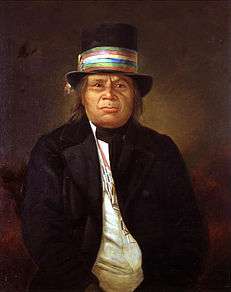Chief Oshkosh
Chief Oshkosh (also spelled Os-kosh or Oskosh or Oshkeeshquay) (1795–August 29, 1858) was the chief of the Menominee American Indians from 1827 until his death. He played a key role in treaty negotiations as the Menominee tried to protect their lands in Wisconsin from being granted to Oneida and other Indians from New York state and European-American pioneers. Oshkosh, Wisconsin, is named after him.
Chief Oshkosh | |
|---|---|
 Menominee Chief Oshkosh | |
| Born | 1795 near Nekoosa, Wisconsin |
| Died | August 29, 1858 |
| Nationality | Native American |
| Predecessor | Chief Tomah |
| Successor | Chief Akwine'me |
Early life
Chief Oshkosh ("Claw")[1] (cf. Ojibwe oshkanzh, "the claw").[2] was born in 1795 near Nekoosa (Point Bas) on the Wisconsin River.[3]
Around the age of 15, he was placed under the guidance of Tomah by his grandfather, the Head Chief. After Tomah and his grandfather died, Oshkosh became the Head Chief in 1827.[1] As a young man he fought on the side of the British during the War of 1812. However, he sided with the Americans during the Black Hawk War of 1832.[3]
Treaties
In the 1836 Treaty of the Cedars, Oshkosh and the Menominee sold 4.2 million acres (17,000 km2) (including all of their lands in the Upper Peninsula of Michigan) for $620,000. Later, in the 1848 Treaty of Lake Poygan, Oshkosh and the Menominee sold their remaining lands in Wisconsin to the United States. In exchange, the government offered them about 600,000 acres (2,400 km2) along the Crow Wing River in Minnesota.[4]
Oshkosh was supposed to lead his tribe to Crow Wing River, but he and other tribal leaders claimed that they had signed the 1848 treaty under pressure. In 1852, the Menominee were allowed to stay on a temporary reservation on the Wolf River in northeastern Wisconsin. Later, the 1854 Wolf River Treaty made this 250,000-acre (1,000 km2) reservation permanent.[5]
Later life
Oshkosh was known to be an alcoholic in his later life. Shortly before his death, he weighed over 400 pounds. He died in Keshena, Wisconsin, in a drunken brawl on August 29, 1858.[6]
In 1926 the Menominee allowed Oshkosh's remains to be moved to Menominee Park in Oshkosh, Wisconsin, where they were interred at the foot of a monument dedicated to him, covered with an inscribed granite slab.[7] Soon after doubts arose as to whether the Menominee had handed over the remains of their revered chief.[8] Some speculate his remains were never removed from the Menominee reservation and a different body was interred at the monument, possibly a woman.[9][10] The monument is usually referred to in city documents as the Oshkosh "burial site" to reflect this.[9]
References
- Menominee Indian Tribe of Wisconsin History Chief Oshkosh Archived October 7, 2007, at the Wayback Machine
- "Ojibwe Dictionary". Freelang. Retrieved March 28, 2007.
- Chief Oshkosh - Wisconsin Historical Society
- Menominee
- "Menominee Culture - Indian Country Wisconsin". Archived from the original on 2007-11-17. Retrieved 2007-11-19.
- Bruce E. Johansen (1999). The Encyclopedia of Native American Economic History. ISBN 9780313306235. Retrieved November 19, 2007.
- Heim, Michael (2004). "41". Exploring America's Highways: Wisconsin Trip Trivia. Wabasha, MN: Exploring America's Highway. p. 212. ISBN 0-9744358-0-5.
- "Chief Oshkosh Not Buried in Oshkosh, Indians Claim". The Milwaukee Journal. August 1, 1926. p. 11. Retrieved May 30, 2018.
- Miles Maguire (October 20, 2016). "City upgrading Chief Oshkosh 'burial site'". Oshkosh Independent. Retrieved May 30, 2018.
- "Chief Oshkosh Day". oshkosh.pastperfectonline.com. Retrieved May 30, 2018.
Further reading
- Cross, Scott. Like a Deer Chased by the Dogs: The Life of Chief Oshkosh. Oshkosh, Wis: Oshkosh Public Museum, 2002.